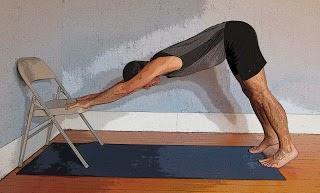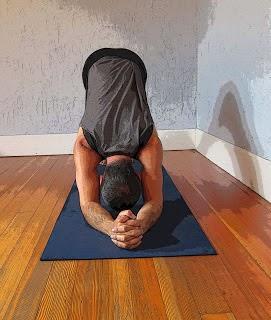 As part of my continuing series of special sequences, I’d like to offer a sequence for building stronger bones. To start, please see one of my previous post on osteoporosis Healthy Bones for Men and Women Alike. When practicing the poses I have chosen for the sequence today, remember some of the suggestions I made in that previous post:
As part of my continuing series of special sequences, I’d like to offer a sequence for building stronger bones. To start, please see one of my previous post on osteoporosis Healthy Bones for Men and Women Alike. When practicing the poses I have chosen for the sequence today, remember some of the suggestions I made in that previous post: “The research data that shows that we can stimulate new bone growth along lines of stress by holding poses for between 8-72 seconds is, for me, the pivotal nuance to add to the yoga practice you are already doing. Because of this, I have been working recently with holding postures for 30-60 seconds, depending on the physical demands of a given pose (for example, holding Downward-Facing Dog for 60 seconds while holding Hand to Foot pose (Hasta Padangustasana), a much more demanding pose on many levels, for 30 seconds.”
So, you will want to experiment with holding your poses in that 30-60 second range. The other key concept to keep in mind relates to the following:
“Remember that engaging opposing muscle groups while doing the pose increases the stimulation of the underlying bone cells that make new bone (this is essentially an isometric contraction around a joint). So, in Downward-Facing Dog I consciously engage the muscles around all the joints I can think of.”
In standing poses, I am not only taking advantage of the weight bearing part of the pose, the feet and legs, but using this isometric muscle contraction around the shoulder joints, for example, and in the contraction of the muscles of the back spine to assist in keeping the posture actively upright. So, if you want to add more poses to the sequence, you can include any of your favorite standing poses and apply these two principles for bone strengthening.
Warm-UpCat/Cow: This pose warms up your spine and its joints, as you are also bearing weight on your wrists, the second most commonly fractured area in people with OP. Start on your hands knees, with a blanket or other padding under your knees. On your inhale arch into a gentle backbend, and then on your exhale round your spine towards the ceiling. Repeat for about six rounds.
Hunting Dog: This pose a great one for building strength in the wrists and spine. See Hunting Dog Pose for basic instructions. Be mindful to keep your chest lifting towards your shoulder blades, especially on the side where your hand is on the ground. And strongly reach your lifted arm and shoulder blade forward, as you reach the lifted leg backward. After you come out, be sure to shake out the wrist of your supporting arm.
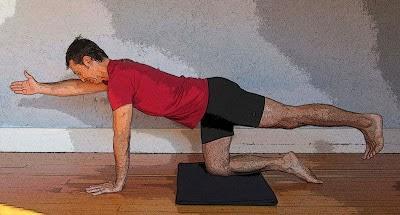
Downward Dog Variation
High Plank Pose: This is another great pose for your wrists as well as your arm bones, and also for your spine as it engages the muscles attached to your spine. Start in Downward-Facing Dog pose, and then shift your shoulders forward until your shoulder joints are directly over your wrist joints. Keep your ribcage lifting up towards your shoulder blades and your elbows strong and straight. The rest of your body should be in a Mountain pose-like shape, so you need to keep your core and legs engaged, while maintaining a natural curve in your lower back. To come out of the pose, swing back to Downward-Facing Dog, then to hands and knees. Afterward, give your wrists a good shake out and brief rest.Active Poses
Extended Side Angle Pose: This is a great pose for the hip joints, the bottom wrist joint and the spine. You could substitute Triangle or Warrior 2 pose here, if you prefer those standing poses. From Mountain pose, step your feet wide apart, turn your right foot and leg out 90 degrees and kick out your back heel an inch or so. Bring your arms up parallel with the floor and bend your front knee. Then side-bend your hips and torso over your front leg and put your right hand on a block on its highest height, placed snug up against the outside of your front shin. Swing your top arm up and overhead, completing the side angle from your back leg through your torso and into your top arm. Push down firmly into the block with your bottom hand and feel your right shoulder blade firm into your chest and slightly down toward your waist. Reach your top arm and shoulder blade strongly forward towards your fingers. Inhale as you come up, relax your arms at your side and repeat on the second side.
Warrior 1: This a good pose to strengthen the spine as it contracts the back muscles that pull on the vertebrae of the entire spine. See Warrior 1 Pose for instructions. You will use this pose to transition into your next pose.
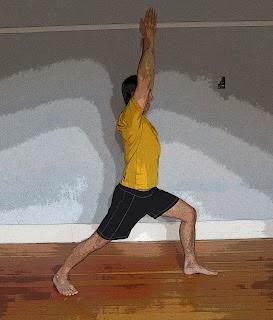
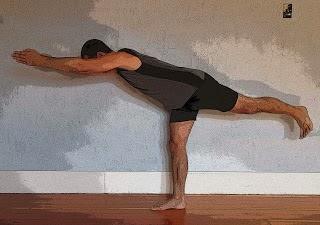
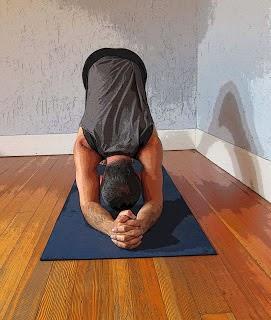
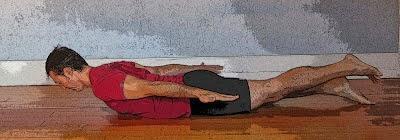
Bridge Pose: This pose will engage your back body muscles, so is a good one for strengthening your spinal vertebrae. Starting on your back, bend your knees to come into Constructive Rest pose, with your feet about four inches from your hips. Warm up by lifting your hips up as you inhale and lowering them down when you exhale, up to six times. Then inhale and stay in the pose for 30-60 seconds, breathing gently in and out the entire time. Press down evenly into your feet, and lift both from your hips and the lower tip of your breastbone. Optionally, you can turn your upper arm bones under the pose, being mindful not to strain on your neck. On an exhalation, release your arms and come out of the pose.
Before moving on to Relaxation pose (Savasana), take a moment to do bring your knees to your chest or rock your knees and hips side to side to release your back muscles.
Cool-DownSavasana: If time permits, take a generous 10-minute rest before heading into your day. Bring attention to your bones and imagine them heavy, dense and strong.

